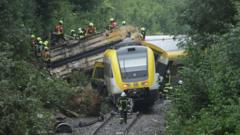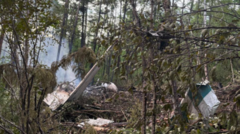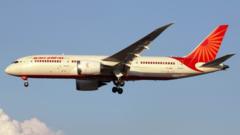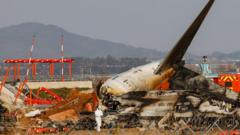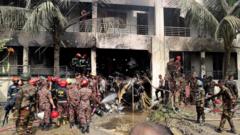Emergency teams in Ahmedabad are working tirelessly to ensure safety and recovery in the wake of the Air India tragedy that claimed over 200 lives.
Air India Crash in Ahmedabad: Recovery Efforts Complicated by Structural Risks

Air India Crash in Ahmedabad: Recovery Efforts Complicated by Structural Risks
Authorities face challenges in recovering victims and investigating the Air India crash due to unstable structures and gas leak threats.
June 12, 2025, 3:18 p.m. ET — Following a tragic incident on Thursday involving an Air India flight that crashed in Ahmedabad, India, resulting in the loss of over 200 lives, experts indicate that the recovery and investigative operations will be highly challenging. Photos from the crash site reveal a scene fraught with unstable buildings and the potential for gas leaks, hampering efforts to recover victims and unravel the cause of the incident.
The recovery process, according to Shawn Pruchnicki, a former airline accident investigator and aviation specialist from Ohio State University, could extend for up to a month. Emergency responders are tasked with meticulously removing large debris, such as the tail of the Boeing Dreamliner, which has become lodged in a nearby structure. "The priority remains on locating potential survivors amongst the wreckage," Pruchnicki emphasized. However, the act of clearing debris also poses a significant risk of causing nearby buildings to collapse.
To mitigate hazards, authorities may need to employ cranes to lift heavy parts of the plane from the impacted buildings—particularly around B.J. Medical College, where five students tragically lost their lives while dining. In addition, responders may have to create temporary supports to stabilize any weakened structures in their search for survivors and additional victims trapped inside.
Before investigators can analyze the wreckage for critical insights into the crash's cause, they must first ensure that the site is secure for operations. This includes recovering the flight’s black box, which houses both the flight data recorder and cockpit voice recorder. According to aviation expert Mike Boyd from the Boyd Group International, accessing this data could take several days.
The highly urbanized environment of Ahmedabad further complicates the situation, as crashes in such densely populated areas increase the risks of collateral casualties, structural damage, and infrastructure disruption, along with the threat of ruptured gas lines. Boyd remarked, "Plane crashes in urban settings present unique hazards that must be carefully navigated by responders."
The recovery process, according to Shawn Pruchnicki, a former airline accident investigator and aviation specialist from Ohio State University, could extend for up to a month. Emergency responders are tasked with meticulously removing large debris, such as the tail of the Boeing Dreamliner, which has become lodged in a nearby structure. "The priority remains on locating potential survivors amongst the wreckage," Pruchnicki emphasized. However, the act of clearing debris also poses a significant risk of causing nearby buildings to collapse.
To mitigate hazards, authorities may need to employ cranes to lift heavy parts of the plane from the impacted buildings—particularly around B.J. Medical College, where five students tragically lost their lives while dining. In addition, responders may have to create temporary supports to stabilize any weakened structures in their search for survivors and additional victims trapped inside.
Before investigators can analyze the wreckage for critical insights into the crash's cause, they must first ensure that the site is secure for operations. This includes recovering the flight’s black box, which houses both the flight data recorder and cockpit voice recorder. According to aviation expert Mike Boyd from the Boyd Group International, accessing this data could take several days.
The highly urbanized environment of Ahmedabad further complicates the situation, as crashes in such densely populated areas increase the risks of collateral casualties, structural damage, and infrastructure disruption, along with the threat of ruptured gas lines. Boyd remarked, "Plane crashes in urban settings present unique hazards that must be carefully navigated by responders."



